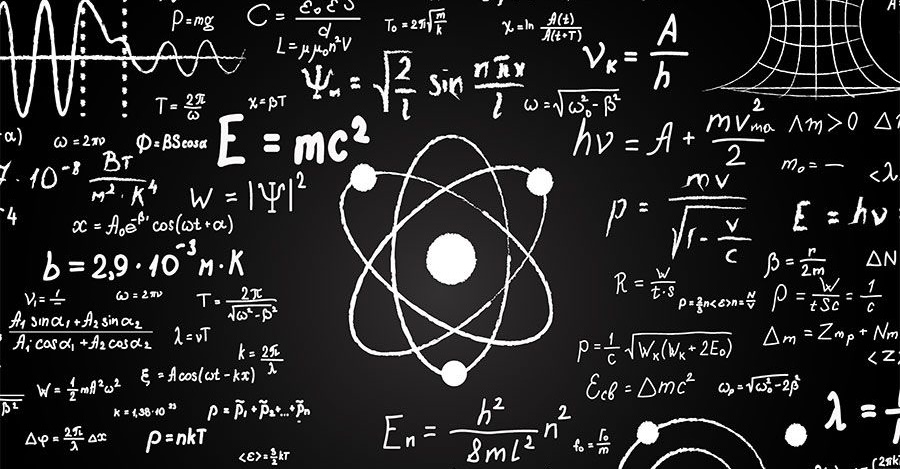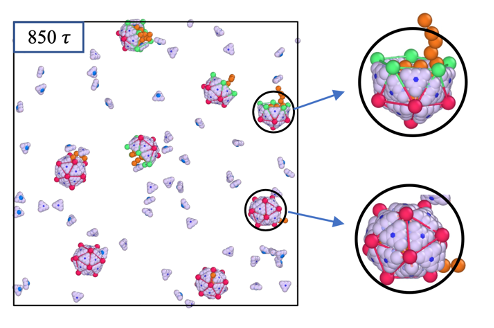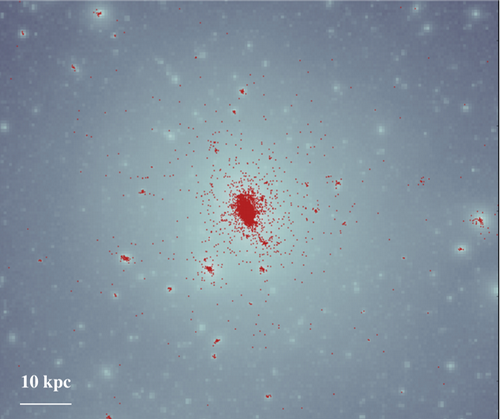Theoretical Physics

About the Faculty

Shohreh Abdolrahimi
Associate Professor
Professor Abdolrahmi works on theoretical gravitational physics and computational general relativity. She studies black holes. Black holes are powerful enough that they warp the fabric of spacetime and serve as a natural experiment where researchers can theoretically "test" the validity of Einstein's general relativity, and investigate alternative theories. Some of Dr. Abdolrahimi’s favorite topics include classical and quantum gravity, black hole physics, large extra dimensions and black hole production at the Large Hadron Collider (LHC) , quantum field theory in a curved spacetime, and quantum effects in accelerated frames. Students working with Dr. Abdolrahimi study different aspects of black holes, such as the black hole properties, study the images of the black holes, and investigate the motion of charged test particle which is the basis for understanding the influence of the magnetic fields on the accretion phenomena into a black hole.
- Email Shohreh Abdolrahimi
Jorge Botana Alcalde
Assistant Professor
Dr. Botana and his group of undergrad researchers have focused on the theoretical study of solid-state systems by using ab initio calculations. His group has studied the structural and chemical properties of crystalline matter under extreme conditions of pressure using density functional theory (DFT) calculations, aided by the systematic structure search algorithm PSO (Particle Swarm Optimization).
In their most recent work, they studied the thermodynamic instability of Fe-U compounds in the conditions in the Earth’s inner core. However, U may exist as point defects within crystalline iron, effectively stabilizing specific iron phases, which could affect Earth's energy budget. They have also studied the high-pressure compounds and alloying of Fe with several light elements (S, O, C, H, Mg), which has implications in the Earth’s inner core properties and the study of steel properties.
Their methods also have allowed Dr. Botana and his group to explore novel high-pressure chemistry, predicting unique chemical phenomena like new and counterintuitive oxidation numbers for elements like Li and Hg, and the existence of ionic crystals where individual electrons occupy ionic sites, independently from any atom.


Siyu Li
Assistant Professor
Professor Li's research focuses on understanding biological assembly and membrane morphology through theoretical calculations and computational simulations. Dr. Li is particularly interested in how mechanical properties influence virus assembly, membrane budding, and elastic shell morphology. To explore these phenomena, Dr. Li has developed models to simulate the dynamics of macromolecular aggregation across various time scales to construct functional membrane structures. Dr. Li’s work has several applications, including the design of responsive shells to enhance the functionality of nanoreactors, packaging of macromolecules for gene delivery, controlled protein assembly, and the development of principles for assembling microcompartments for biochemical or energy applications.
Sujoy Modak
Assistant Professor
Dr. Modak studies the foundation, intersection and phenomenology of quantum and gravitational theories. Dr. Modak uses a semi-classical approach where the background spacetime classical, described by a curved spacetime, while all matter fields get full quantum treatment. He has built theoretical models to understand the black hole evaporation and information problem, quantum origin of the seeds of cosmic structure in the very early universe, and particle creation in cosmological settings. In addition, he has worked on the foundation of quantum theory, specifically using the “objective collapse model” approach to better understand the division between the classical and quantum systems. Recently, Dr. Modak has made some proposals to indirectly test quantum gravity effects in low energy table-top experiments. He has published 35 research articles in the above topics, and some of them are co-authored by undergraduate students.


Alex Small
Professor Small studies two simple questions: How much information is carried by a beam of light, and how can we use this knowledge to extract information from a live cell? Dr. Small studies the fundamental limits to superresolution microscopy, a family of fluorescence techniques that enable imaging of cells at nanometer resolution, revealing details not accessible to a conventional light microscope. As a theorist, Dr. Small’s work is mostly focused on understanding the theory that replaces Abbe’s diffraction limit, understanding the ways in which image analysis algorithms work with superresolution, and developing and benchmarking computational tools for superresolution. Additionally, Dr. Small has projects in light scattering (developing analytical and computational tools for studying scattering from particles in novel geometries) and percolation theory, focused on percolation in networks with novel structures applicable to new materials systems, and also applying some percolation insights to theoretical work on superresolution.
Coral Wheeler
Assistant Professor
Professor Wheeler is a theoretical astrophysicist whose research involves running and analyzing the next generation of high resolution cosmological hydrodynamic galaxy simulations to make testable predictions for low mass (102 MSun < M* < 107 MSun) galaxies that can be used to answer important questions about the Universe by looking no further than the neighborhood near our own Milky Way, where these tiny galaxies reside. The high dark matter content and shallow potential wells of these objects make them excellent testbeds for differing theories of galaxy formation. I simulate these low-mass galaxies at high enough resolution to test the extreme end of galaxy formation physics, investigate challenges to our current cosmological paradigm, and improve galaxy formation models. Armed with these theoretical tools and a wealth of observational data, my primary research objective is to answer important questions about our Universe such as: What is the nature of dark matter? What were the conditions of the early Universe? Do our galaxy formation models accurately describe all galaxies?

J. Botana, B. Urbach, C. Moffett-Smith, Q. Gilbert, E. McGarvey, "Uranium at the conditions of the Earth’s inner core: Fe-U forms and implications", submitted to PHYSICA B (2024)
Li, S., Tresset, G., & Zandi, R. (2024). Switchable Conformation in Protein Subunits: Unveiling Assembly Dynamics of Icosahedral Viruses. arXiv:2409.00226
S. K. Modak, “Recent Efforts Towards Understanding the Early Universe from a Fundamental Quantum Perspective,” J. Phys. Res. Edu. Vol 2, pp 16-35 (2024).
Z. Liu, W. Hou, J. Botana, Y. Sun, Y. Sun, W. Yi, Y. Chen, "Unexpected Metastable High-Temperature Superconducting Hydride LaCaH12 with an Irregular Cage Structure at High Pressure," JOURNAL OF PHYSICAL CHEMISTRY C, 127, 23870 (2024)
F. Torres, S. K. Modak and A. Aranda, “New Insights on the Quantum-Classical Division in Light of Collapse Models,” Found. Phys. 53, no.4, 73 (2023).
Hopkins, Philip F.; Wetzel, Andrew; Wheeler, Coral ; et al. FIRE-3: updated stellar evolution models, yields, and microphysics and fitting functions for applications in galaxy simulations, (2023) MNRAS, 519, 315, DOI: 10.1093/mnras/stac3489
C. Villalpando and S. K. Modak, “Minimal length effect on the broadening of free wave-packets and its physical implications,” Phys. Rev. D 100, no.2, 024054 (2019).
Wheeler, Coral; Hopkins, Philip F.; Pace, Andrew B., et al., Be it therefore resolved: cosmological simulations of dwarf galaxies with 30 solar mass resolution, (2019) MNRAS, 489, 4447, DOI: 10.1093/mnras/stz2887
Wheeler, Coral; Hopkins, Philip F.; and Doré, Olivier, The Radial Acceleration Relation Is a Natural Consequence of the Baryonic Tully-Fisher Relation, (2019), ApJ, 882, 46, DOI: 10.3847/1538-4357/ab311b
Li, S., Roy, P., Travesset, A., & Zandi, R. (2018). Why large icosahedral viruses need scaffolding proteins. PNAS, 115(43), 10971-10976
W. Yi, J. Botana, J. Liu, M. Miao, "Microporosity as a new property control factor in graphene-like 2D allotropes," JOURNAL OF MATERIALS CHEMISTRY A, 6, 10348 (2018)
Z. Liu, J. Botana, A. Hermann, S. Valdez, E. Zurek, D. Yan, H. Lin, M Miao, "Reactivity of He with ionic compounds under high pressure," NATURE COMMUNICATIONS, 9, 951 (2018)
J. Botana, M. Miao, "Helium Shows New Chemistry Not Seen Anywhere Else," CHEM, 2, 466 (2017)
J. Botana, J. Brgoch, C. Hou, M. Miao, "Iodine Anions beyond −1: Formation of LinI (n = 2–5) and Its Interaction with Quasiatoms," INORGANIC CHEMISTRY, 55, 9377 (2016)
S. Abdolrahimi, R. B. Mann, and C. Tzounis, Double images from a single black hole, Phys. Rev. D 92, 124011, (2015) DOI: 10.1103/PhysRevD.92.124011
S. K. Modak, L. Ortiz, I. Pena and D. Sudarsky, “Non-Paradoxical Loss of Information in Black Hole Evaporation in a Quantum Collapse Model,” Phys. Rev. D 91, no.12, 124009 (2015).
S. Abdolrahimi, R. Mann, and C. Tzounis, Distorted Local Shadows, Phys. Rev. D, 91, 084052 (2015) DOI: 10.1103/PhysRevD.91.084052
S. Abdolrahimi, J. Kunz, P. Nedkova, and C. Tzounis, Properties of the distorted Kerr black hole, JCAP, 12, 009 (2015) DOI: 10.1088/1475-7516/2015/12/009
S. Abdolrahimi, J. Kunz, and P. Nedkova, Myers-Perry Black Hole in External Gravitational Field, Phys. Rev. D, 91, 064068 (2015) DOI: 10.1103/PhysRevD.91.064068
S. Abdolrahimi and A. A. Shoom, Distorted Five-Dimensional Electrically Charged Black Hole, Phys. Rev. D, 89, 024040, (2014) DOI: 10.1103/PhysRevD.89.024040
J. Botana, M. Miao, "Pressure-stabilized lithium caesides with caesium anions beyond the −1 state," NATURE COMMUNICATIONS, 5, 4861-1 (2014)
S. Singh, S. K. Modak and T. Padmanabhan, “Evolution of quantum field, particle content and classicality in the three-stage universe,” Phys. Rev. D 88, no.12, 125020 (2013).
S. Abdolrahimi, C. Cattoën, D. N. Page, and S. Yaghoobpour-Tari, Large Randall-Sundrum II Black Holes, Phys. Lett. B, 720, 405 (2013) DOI: 10.1016/j.physletb.2013.02.034
J. Botana, M. Pereiro, D. Baldomir and J.E. Arias, "Density functional study of the magnetic properties of Bi4Mn clusters: Discrepancy between theory and experiment," JOURNAL OF CHEMICAL PHYSICS, 134, 034307-1 (2011)
S. Abdolrahimi, A. A. Shoom, and D. N. Page, Distorted 5-Dimensional Vacuum Black Hole, Physical Review D, 82, 124039, (2010) DOI: 10.1103/PhysRevD.82.124039
S. Abdolrahimi, V. P. Frolov, and A. A. Shoom, Interior of a charged distorted black hole, Physical Review D, 80, 024011, (2009) DOI: 10.1103/PhysRevD.80.024011